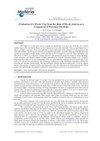一种利用浓酸和氧化剂的混合物对致密和多孔钛表面进行化学定型的方法
IF 1.2
4区 材料科学
Q4 MATERIALS SCIENCE, MULTIDISCIPLINARY
引用次数: 1
摘要
用等体积的H2SO4和H2O2混合溶液处理工业致密纯钛片和粉末冶金加工的多孔钛样品2或4小时。通过扫描电镜、能量色散x射线能谱、共聚焦扫描光学显微镜、x射线衍射和x射线光电子能谱进行表征。分析表明,使用浓酸和氧化剂组合的化学图像化方法能够在致密和多孔的钛表面产生纳米纹理。此外,处理后的样品呈现出主要由二氧化钛组成的氧化层,由于羟基的存在而带负电荷,这是有利于磷灰石成核和蛋白质吸附的重要因素。还观察到,在多孔样品上比在致密样品上更有效地形成氧化物,这可以用多孔介质固有的更高表面积来解释。最后,研究结果表明,两种处理时间都促进了类似的表面性质的改变,如纳米结构和化学成分,这表明2小时的时间足以在纳米尺度上诱导表面改变。关键词:钛;表面改性;化学氧化、粉末冶金。本文章由计算机程序翻译,如有差异,请以英文原文为准。
A chemical patterning approach of dense and porous titanium surfaces by using a combination of concentrated acid and oxidant
Commercially dense pure titanium sheets and porous titanium samples processed by powder metallurgy were treated with a mixture consisting of equal volumes of H2SO4 and H2O2 for 2 or 4 hours. Characterization was performed by scanning electron microscopy, energy dispersive X-ray spectroscopy, confocal scanning optical microscopy, X-ray diffraction, and X-ray photoelectron spectroscopy. The analyses showed that the chemical patterning approach using a combination of concentrated acid and oxidant was able to generate a nanotexture on dense and porous titanium surfaces. In addition, the treated samples presented an oxide layer consisting predominantly of titanium dioxide with negative charge conferred by the presence of hydroxyl groups, which is an important factor that favors apatite nucleation and protein adsorption. It was also observed that oxide formation was more effective on porous samples than on dense samples, which can be explained by the higher surface area intrinsic to porous media. Finally, the findings indicated that both treatment times promoted similar modifications in surface properties, such as nanotexture and chemical composition, suggesting that the time of 2 hours were enough to induce the surface alterations at the nanoscale. Keywords: titanium; surface modification; chemical oxidation, powder metallurgy.
求助全文
通过发布文献求助,成功后即可免费获取论文全文。
去求助
来源期刊

Materia-rio De Janeiro
MATERIALS SCIENCE, MULTIDISCIPLINARY-
CiteScore
1.00
自引率
25.00%
发文量
51
审稿时长
6 weeks
期刊介绍:
All the articles are submitted to a careful peer-reviewing evaluation process by the journal''s Editorial Board. The Editorial Board, reviewers and authors make use of a web based proprietary automated tool to deal with the reviewing procedures.the Revista Matéria''s article reviewing restricted access system - SEER. Authors are not informed about the identity of the reviewers.
 求助内容:
求助内容: 应助结果提醒方式:
应助结果提醒方式:


